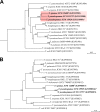Reply to Perez del Molino Bernal and Agüero Balbin, " seqA1 Is a Useful Target for Identification of Tsukamurella pulmonis"
- PMID: 28442613
- PMCID: PMC5405280
- DOI: 10.1128/JCM.00238-17
Reply to Perez del Molino Bernal and Agüero Balbin, " seqA1 Is a Useful Target for Identification of Tsukamurella pulmonis"
Figures

Comment on
-
The groEL Gene Is a Promising Target for Species-Level Identification of Tsukamurella.J Clin Microbiol. 2017 Feb;55(2):649-653. doi: 10.1128/JCM.02260-16. Epub 2016 Dec 14. J Clin Microbiol. 2017. PMID: 27974536 Free PMC article. No abstract available.
-
seqA1 Is a Useful Target for Identification of Tsukamurella pulmonis.J Clin Microbiol. 2017 May;55(5):1591. doi: 10.1128/JCM.00198-17. J Clin Microbiol. 2017. PMID: 28442612 Free PMC article. No abstract available.
References
-
- Woo PCY, Woo GKS, Lau SKP, Wong SSY, Yuen K-Y. 2002. Single gene target bacterial identification. groEL gene sequencing for discriminating clinical isolates of Burkholderia pseudomallei and Burkholderia thailandensis. Diagn Microbiol Infect Dis 44:143–149. doi:10.1016/S0732-8893(02)00439-X. - DOI - PubMed
-
- Woo PCY, Lau SKP, Woo GKS, Fung AMY, Ngan AHY, Hui WT, Yuen K-Y. 2003. Seronegative bacteremic melioidosis caused by Burkholderia pseudomallei with ambiguous biochemical profile: clinical importance of accurate identification by 16S rRNA gene and groEL gene sequencing. J Clin Microbiol 41:3973–3977. doi:10.1128/JCM.41.8.3973-3977.2003. - DOI - PMC - PubMed
Publication types
MeSH terms
LinkOut - more resources
Full Text Sources
Other Literature Sources
Molecular Biology Databases

